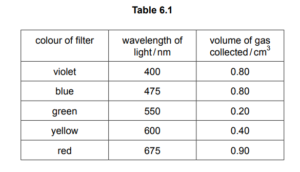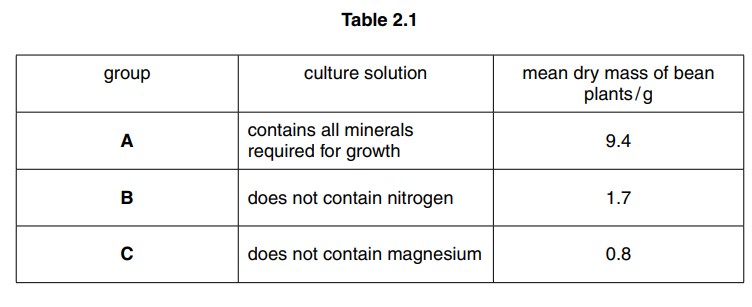Question
(a) State the balanced chemical equation for photosynthesis

A student investigated the effect of different wavelengths of light on the rate of photosynthesis of
the water plant, Cabomba.
The student used the apparatus shown in Fig. 6.1.

(b) The student collected the gas produced by the plant for five minutes. The results are shown
in Table 6.1.

Describe the effect of wavelength of light on the rate of photosynthesis as shown in the student’s
results in Table 6.1.
You will gain credit if you use data from the table.
(c) State how the student would calculate the rates of photosynthesis from the results in Table 6.1.
(d) State why the student:
(i) kept the lamp at the same distance during the investigation, [1]
(ii) used sodium hydrogencarbonate solution [1]
(e) State three uses in a plant of the carbohydrate produced in photosynthesis.
1
2
3
Answer/Explanation
Ans
6 (a) ![]()
(b) as wavelength increases, rate (of photosynthesis) decreases and
increases ;
high rates in, blue and violet and red/ 400–475nm and 675nm ;
low(est) rate in, green and yellow/ 550–600nm ;
either
maximum rate = 0.9cm3, at 675nm/red
or
minimum rate = 0.2cm3, at 550nm/ green ;
(c) divide the volumes by, five (minutes)/ time ;
(d) (i) to keep the light intensity the same ;
(ii) to provide carbon dioxide/ so carbon dioxide is not a limiting factor/
so the only limiting factor is wavelength ;
(e) for, respiration/ energy ;
converted to sucrose ;
used to make, nectar/ fruits ;
used to make, cellulose/ lignin ;
used in cell walls ;
used to make, starch/ oils / fats ;
storage ;
used to make, amino acids ;
used to make, chlorophyll ;
Question
(a) Water is one requirement for photosynthesis.
State two other requirements needed by plants to carry out photosynthesis.
1 ………………………………………………………………………………………………………………………………
2 ………………………………………………………………………………………………………………………………
[2]
Answer/Explanation
Ans:
carbon dioxide ;
light energy ;
chlorophyll ;
Table 4.1 shows the number of hectares of forested area in some countries in Africa in the years 1990, 2000 and 2005.
Table 4.1
| country | hectares of forest per 1000 hectares of land | ||
| 1990 | 2000 | 2005 | |
| Cameroon | 25 | 22 | 21 |
| Tanzania | 41 | 37 | 35 |
| Nigeria | 17 | 13 | 11 |
| Zambia | 49 | 45 | 43 |
| Zimbabwe | 22 | 19 | 18 |
Question
(b) Calculate the percentage loss of forested area in Nigeria between 2000 and 2005.
Show your working and give your answer to the nearest whole number.
…………………………………………………… %
[2]
Answer/Explanation
Ans:
(2 ÷ 13) ˣ 100 ;
15(%) ;
(c) Some forested areas are cleared to provide land to grow crop plants. Deforestation reduces
the local rainfall and the concentration of water vapour in the air.
Question
(i) Describe and explain how a reduced concentration of water vapour in the air would
increase the movement of water through crop plants.
………………………………………………………………………………………………………………………….
………………………………………………………………………………………………………………………….
………………………………………………………………………………………………………………………….
………………………………………………………………………………………………………………………….
………………………………………………………………………………………………………………………….
………………………………………………………………………………………………………………………….
………………………………………………………………………………………………………………………….
[3]
Answer/Explanation
Ans:
increased rate of transpiration ;
greater concentration of water vapour inside the leaf than outside ;
more water vapour diffuses out of the leaf ;
through stomata ;
more water is drawn up through xylem/ transpiration pull ;
Question
(ii) Describe how water moves from the soil into the roots of crop plants.
………………………………………………………………………………………………………………………….
………………………………………………………………………………………………………………………….
………………………………………………………………………………………………………………………….
………………………………………………………………………………………………………………………….
………………………………………………………………………………………………………………………….
………………………………………………………………………………………………………………………….
…………………………………………………………………………………………………………………………
[3]
Answer/Explanation
Ans:
by osmosis ;
the soil has a higher water potential than the root cells ;
water moves from an area of higher water potential to lower water potential ;
across a partially permeable membrane ;
ref to root hair cell ;
Question
(d) Describe the consequences of deforestation on the animals that live in forests.
…………………………………………………………………………………………………………………………………
…………………………………………………………………………………………………………………………………
…………………………………………………………………………………………………………………………………
…………………………………………………………………………………………………………………………………
…………………………………………………………………………………………………………………………………
…………………………………………………………………………………………………………………………………
…………………………………………………………………………………………………………………………………
…………………………………………………………………………………………………………………………………
…………………………………………………………………………………………………………………………………
[4]
Answer/Explanation
Ans:
1 loss of habitat ;
2 population decrease /migration ;
3 extinction /endangerment, of species ;
4 loss of biodiversity ;
5 less food ;
6 disruption of, food chains /food webs ;
Fig. 2.1 shows an apparatus used to study the effect of minerals on plant growth.

(a) The plant grows better if air is bubbled through the solution surrounding its roots. Name the process that uses oxygen from the air to release energy in the plant’s cells.
………………………………………………………………………………………………………………………….
(b) An investigation was carried out into bean plants, using the apparatus shown in Fig. 2.1. Table 2.1 shows the mean dry mass of three groups of bean plants grown in different solutions for seven days

(i) Explain why, compared with group A, the dry mass was less in group B and group C.
………………………………………………………………………………………………………………………….
………………………………………………………………………………………………………………………….
………………………………………………………………………………………………………………………….
………………………………………………………………………………………………………………………….
………………………………………………………………………………………………………………………….
………………………………………………………………………………………………………………………….
………………………………………………………………………………………………………………………….
……………………………………………………………………………………………………………………..
(ii) Describe the expected appearance of plants in group C at the end of the investigation.
……………………………………………………………………………………………………………………..
Answer/Explanation
Ans:
2 (a) (aerobic) respiration;
(b) (i) link of lower dry mass with less growth;
B (no nitrogen) plant cannot produce proteins / amino acids /enzymes;
C (no magnesium) plant cannot make chlorophyll; cannot photosynthesise/ produce carbohydrate/ sugar/ glucose;
reference to growth (more cells / larger cells) requiring synthesis of chemicals /AW;
no carbohydrates / glucose/ sugar made means limited energy supplies (for growth);
(ii) (C plant’s) leaves pale green/ yellow/AW; growth stunted/AW;
Question
Fig. 2.1 shows an apparatus used to study the effect of minerals on plant growth.

(a) The plant grows better if air is bubbled through the solution surrounding its roots. Name the process that uses oxygen from the air to release energy in the plant’s cells.
………………………………………………………………………………………………………………………….
(b) An investigation was carried out into bean plants, using the apparatus shown in Fig. 2.1. Table 2.1 shows the mean dry mass of three groups of bean plants grown in different solutions for seven days

(i) Explain why, compared with group A, the dry mass was less in group B and group C.
………………………………………………………………………………………………………………………….
………………………………………………………………………………………………………………………….
………………………………………………………………………………………………………………………….
………………………………………………………………………………………………………………………….
………………………………………………………………………………………………………………………….
………………………………………………………………………………………………………………………….
………………………………………………………………………………………………………………………….
……………………………………………………………………………………………………………………..
(ii) Describe the expected appearance of plants in group C at the end of the investigation.
……………………………………………………………………………………………………………………..
Answer/Explanation
Ans:
2 (a) (aerobic) respiration;
(b) (i) link of lower dry mass with less growth;
B (no nitrogen) plant cannot produce proteins / amino acids /enzymes;
C (no magnesium) plant cannot make chlorophyll; cannot photosynthesise/ produce carbohydrate/ sugar/ glucose;
reference to growth (more cells / larger cells) requiring synthesis of chemicals /AW;
no carbohydrates / glucose/ sugar made means limited energy supplies (for growth);
(ii) (C plant’s) leaves pale green/ yellow/AW; growth stunted/AW;
Question
Photosynthesis takes place in the leaves of plants.
(a) (i) Leaves absorb light energy and this is converted into chemical energy.
State where in leaves this energy change takes place.
![]()
(ii) Complete the word equation for photosynthesis.

(b) Describe how water enters a plant from the soil.

▶️Answer/Explanation
Ans:

